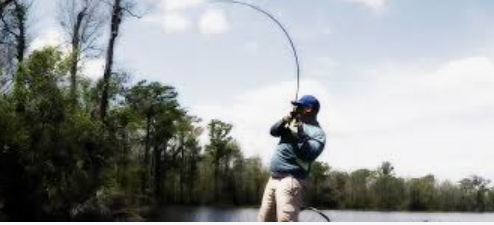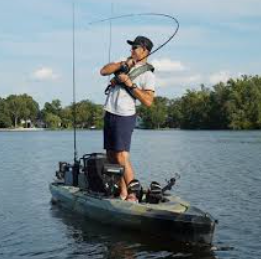There are so many basics to fishing that it often seems more complicated than it really is. Boil it down to the simplest form; you only need a fishing rod, reel, some line, a hook or lure and maybe some bait.

Wait, one of the most important things in this equation is a body of water. Streams, Creeks and Rivers will also work for this experience as well. Lake Wallenpaupack is a perfect example of a fisherman’s delight. It can be tough but lots of fish and even more ways to fish for them.
This article has everything to do with you, the angler having a decent hookset. From the time we are very little, in our youth I’d say, most of us learned the importance of casting, baiting our hooks, tying a knot but even as a little kid we rarely ripped the lips off the fish we are trying to catch.
I still see so many misses due to poor hookset’s and in my own defense I am probably overzealous when it comes to setting the hook. I’m the guy that rips the fish, stick, log, anchor, weed bed and rocks out of the water all at the same time. A nibble is the same as a bite to me, I want to make sure that hook is buried in the lip and not in the gut.

So, what are the basics of the hookset? It’s more than yanking your rod tip up. That’s a great start and correct but not the only thing to consider.
First, let’s start by stating the obvious. In order to set the hook you need to have a fish interested in whatever you are presenting. Once that happens the fun can begin.

- Does the fish believe there is a fisherman on the other end of the bait they just inhaled? Nope, but some fish do learn over many years of heavy fishing. That is not what we are talking about here, most times and depending on fish species, a fish thinks it has a food item. When said fish feels the resistance it believes whatever it’s eaten is attempting to get away. They usually clamp down harder. Again, how you manage this process also depends on bait fishing versus using artificials. Soft baits like rubber worms and creature baits provide a bit more time for you feel your way through the bite.
- Be patient with the fish, except when bait fishing. You wait too long while bait fishing and you will surely end up with a gut hooked fish and we all know how those stories typically end for the fish. If you are trout fishing and you know you are going to eat them, that doesn’t matter – let them take it but for other game species like Smalls, Large, Stripers or toothy critters like Pickerel & Pike it’s best to get on them early in the bite. When a fish has a prey item, the more the fish believes it’s got lunch and locks down on that item. You know what I’m talking about for the guys that fish the soft plastics in the summer months. Let them mouth it and prepare for a hookset beyond hooksets…Too early will lead to misses especially during off seasons, the bite can be soft.
- It’s important to feel the fish on the other end of the line before you set the hook. This comes in many forms, literally the line is running or maybe your rod is bouncing up and down like your girlfriend on a trampoline, better yet you can feel them through your rod handle – at that time you are green-lit to set the hook.

- Timing is critical, set the hook to early and you may have lost your fish, set the hook to late and you may have lost your fish. This is probably one of the most important aspects that all fisherman need to learn as they consider when and how to set the hook. Fish species, time of year and your presentation all play a big part. We all know that certain fish attack differently, we also know that spring and summer offer better or more aggressive fish and the way you are fishing can impact how and when to set the hook. These are all things you need to learn; it takes years to learn the subtle nuances between fish, times of year and how you are fishing and what you are fishing. Work at it, fish don’t all act the same folks….you know this.
- Before you set the hook, you also want to be sure that you remove as much if not all the slack line between your reel and the fish. By doing this, you will maximize the force of the hook into the mouth/lip of the fish. How many times have you gotten excited by a bite only to set the hook and feel nothing on the other end. You gotta tighten up the line, feel the weight of the fish and then rip those lips.

- We have received several questions about setting the hook while trolling or drifting, this also holds true for hook types. Most times if you are moving at a fair pace the fish will automatically move the barb to break to skin, however there is no rule about setting the hook once a fish has shown interest in your lure or bait while trolling. Treble hooks can be tough, we’ve seen and heard many fishermen that troll cutting off the last treble and replacing it with a singular hook – common on spoons and stick baits. Circle hooks and octopus hooks should naturally hook a fish but again, you always want to give it a nice firm tug to ensure you’ve broken the skin and pushed the barb through.
Here are some useful techniques that may help you perform a better hookset.
- Be sure you are on solid footing before you give a good hookset. This includes from land, from a dock, on a boat, etc. You don’t have to worry about setting your stance while you are in a kayak but I’ve seen a few folks roll over on a good hookset. Feet and lower body are ready, sitting down requires much more of a relaxed upper body. I’ll explain that next.
- Relax your upper body, your shoulders, arms and back. If you’ve hunted before, you know the importance of having a relaxed upper body and good breathing. Same goes for fishing, it’s easy to lose a fish because you are too stiff.
- Keep your elbows in tight, this tends to keep the power and force of your hookset in the tip of your rod where you’ll be able to maximize your energy to the hook.
- Move your rod tip over your shoulder, not your head. You’ll conk yourself. Again, focus your energy into a firm and solid motion over your shoulder, some guys and girls will hookset to the side and I guess it depends on how and where you are fishing but that approach is okay too…
- Keeping steady pressure on the fish the entire time you have it hooked, fish run all over the place, especially big ones. You want to keep your rod tip up and out in front of the direction they are running with solid pressure. The idea of pulling them in the direction you want can work against you early on in the fight. Pressure and rod tip up, as they shift direction you shift with them.
- Crank the reel and make sure you have constant tension on the line. One of the worst mistakes is giving a big fish slack. They love it and you will hate it.
- Soft mouth and hard mouth fish – remember, fish species are different. You don’t have to work a perch the same way you work a large rainbow trout or the same way you work a muskie. A hook can be ripped right through a soft mouthed fish, while a hard mouth fish requires an extra oomph to seal the deal.
Nothing too amazing here but hopefully it helps you during your next outing whenever that might be. Always open to your suggestions and feedback. Now go out there and catch some fish.
